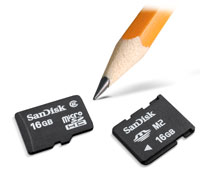SanDisk announced today that it is bringing the world's first 16GB microSDHC and Memory Stick Micro (M2) memory cards to market. Along with mobile phones, these finger-nail sized cards can be used in other devices, including video cameras, GPS receivers or MP3 players.

SanDisk Corporation (NASDAQ: SNDK), a global leader in flash memory products, today announced it is bringing to market its 16GB* microSDHC™ and Memory Stick Micro (M2)® mobile memory cards - the world’s largest removable storage capacity for mobile phones. Best Buy Mobile (NYSE: BBY) and Verizon Wireless (NYSE: VZ) stores are the first major retail outlets in the United States to carry the 16GB capacity.
The fingernail-sized 16GB memory cards allow consumers to “wake up” the many storage-intensive features offered by today’s portable handsets such as music and video playback, high-definition digital camera functions, gaming and GPS applications. In addition to the mobile phone, consumers can use the 16GB microSDHC card in a multitude of other devices, including video cameras, GPS receivers or MP3 players with a microSD™ slots such as SanDisk’s Sansa® players.
"Handsets have become far more than just phones - they’ve become mobile jukeboxes, mobile offices, even mobile movie theaters," said Avi Greengart, Research Director for Mobile Devices at Current Analysis. "Flash memory cards have increased in storage capacity, but even an 8GB card may be too small for anyone with GPS map data, a few movies, a game or two, a presentation file and other applications. There is an acute need for more mobile storage capacity. 16GB gives consumers the ability to carry their digital content with them and still have room to do more with their mobile phones."
SanDisk’s 16GB microSDHC card has an MSRP of $99.99 and the 16GB M2 card has an MSRP of $129.99. The new 16GB capacity will be available at Best Buy Mobile stores in October and Verizon Wireless stores in November – the only major retailers in the United States to carry this mobile storage capacity in 2008.

